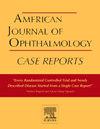Basal cell carcinoma and squamous cell carcinoma of the conjunctiva in a single lesion
Q3 Medicine
引用次数: 0
Abstract
Introduction
Basal cell carcinoma (BCC) occurrences in the conjunctiva are exceptionally rare. These lesions become exceedingly rarer next to an adjacent area of squamous cell carcinoma. A collision tumor of both basal cell and squamous cell carcinoma is infrequently encountered in the literature.
Case presentation
An elderly male patient was evaluated for concern of ocular surface squamous neoplasia on his left conjunctiva. The lesion appeared as a tan-white elevated lesion with atypical vessels in papillary fronds. The patient underwent surgical excision of the lesion, and the tissue was sent to ocular pathology for histopathologic evaluation. The final diagnosis was basal cell carcinoma and squamous cell carcinoma. The two tumors of both basal cell carcinoma and squamous cell carcinoma were juxtaposed with an abrupt transition zone with no fluidity of differentiation. The lesion had typical features for BCC with positive stain for Bcl-2, P63, P53, CD10, and BerEP4. Additionally, the SCC region stained positive for EMA, P63, and P53.
Conclusion
We report a single lesion of the conjunctiva with features of both basal cell carcinoma and squamous cell carcinoma. This case report describes a unique case of two independent neoplasms of the conjunctiva. This further adds to the literature of collision tumors to characterize the lesion with appropriate immunohistochemical analysis.
结膜基底细胞癌和鳞状细胞癌的单一病变
基底细胞癌(BCC)发生在结膜是非常罕见的。这些病变在鳞状细胞癌的邻近区域变得非常罕见。基底细胞癌和鳞状细胞癌的碰撞瘤在文献中并不常见。一例老年男性患者因左结膜眼表鳞状瘤变而接受检查。病变表现为棕白色升高灶,乳头状叶内有非典型血管。患者接受手术切除病变,并将组织送至眼部病理进行组织病理学评估。最终诊断为基底细胞癌和鳞状细胞癌。基底细胞癌和鳞状细胞癌的两个肿瘤并置在一个突变的过渡区,没有分化的流动性。病变具有典型的BCC特征,Bcl-2、P63、P53、CD10和BerEP4染色阳性。此外,SCC区域的EMA、P63和P53染色呈阳性。结论我们报告一例具有基底细胞癌和鳞状细胞癌双重特征的结膜病变。本病例报告描述了两个独立的结膜肿瘤的独特病例。这进一步增加了碰撞肿瘤的文献,用适当的免疫组织化学分析来表征病变。
本文章由计算机程序翻译,如有差异,请以英文原文为准。
求助全文
约1分钟内获得全文
求助全文
来源期刊

American Journal of Ophthalmology Case Reports
Medicine-Ophthalmology
CiteScore
2.40
自引率
0.00%
发文量
513
审稿时长
16 weeks
期刊介绍:
The American Journal of Ophthalmology Case Reports is a peer-reviewed, scientific publication that welcomes the submission of original, previously unpublished case report manuscripts directed to ophthalmologists and visual science specialists. The cases shall be challenging and stimulating but shall also be presented in an educational format to engage the readers as if they are working alongside with the caring clinician scientists to manage the patients. Submissions shall be clear, concise, and well-documented reports. Brief reports and case series submissions on specific themes are also very welcome.
 求助内容:
求助内容: 应助结果提醒方式:
应助结果提醒方式:


